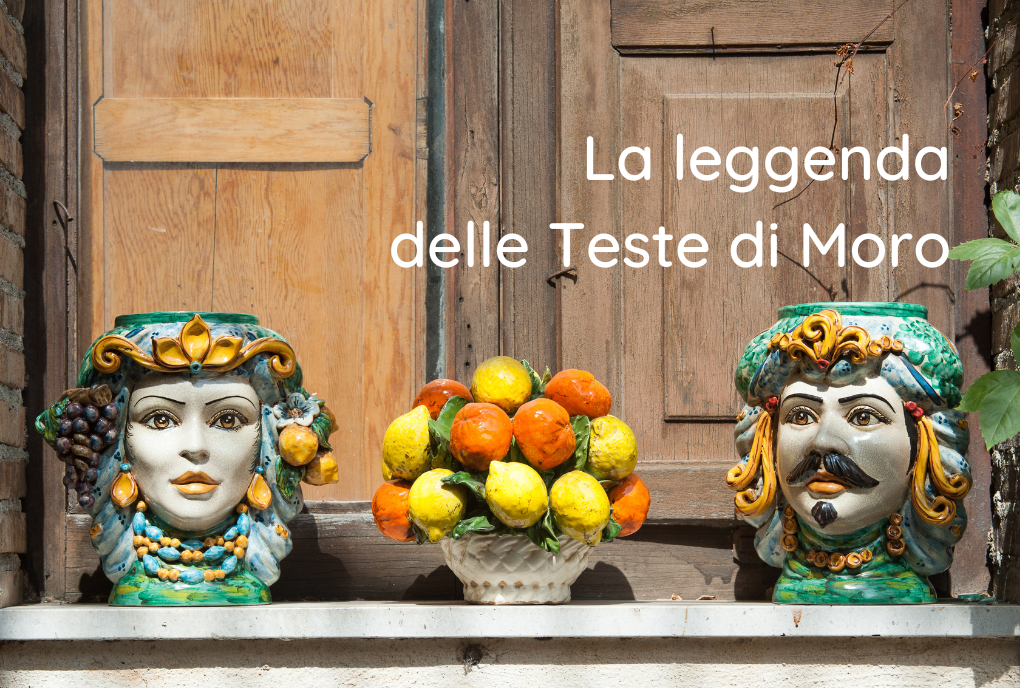
Moorheads: a story of love, passion, revenge and basil
An iconic object of Sicilian tradition, Teste di Moro ceramic vases are now a globally recognized symbol. They carry with them the charm of the love-death combination, the craftsmanship of the hands of artisans, and the perfect lines to be furnishing and design complements.
A legend from afar
Those who have been to Sicily at least once will surely have noticed two very recurring faces, who almost always travel in pairs. These are the Moorheads: the face of a man, specifically a Moor, and a light-skinned young woman. Less well known, however, is the legend behind these two ceramics.
-
The meeting
We are located in Palermo around the year 1100, the period of the Arab domination in Sicily.
In the historic Al Hàlisah district (today Kalsa, from the Arabic khalisa, “the chosen one,” for the fortified citadel and the emir’s court located within it) lives a young maiden who, locked in her home because of her father’s jealousy, devotes her days to caring for the plants that decorate her balcony.
One afternoon, a handsome dark-haired soldier, walking through the streets of the area, sees her and falls madly in love with her. Overwhelmed by passion, the young man cannot hide this feeling and promptly decides to declare his love.
The girl happily reciprocates the attentions of the Moor who, however, soon has to admit that he must return to the distant lands of the East, where his wife and children are waiting for him.
-
Revenge
The maiden, moved by disappointment and jealousy, he waits for nightfall to take his life so that he can always have it with him. He then decided to cut off his head and turn it into something very similar to a vase inside which he grew a sprout of basil (considered, at the time, a very prestigious spice, to the point of being called “the herb of kings”).
Thanks to all the tears the maiden sheds daily, the plant becomes so strong and lush as to attracts the attention of all the neighbors, who from that moment on begin to replicate the Moorhead-shaped pots to grow their plants in the same way.
Boccaccio’s version of the Decameron
Then there is a second version of the story, the one told by Boccaccio in his collection of novelle.
-
The love story
This is Messina, Lisabetta, young girl noble and fatherless, lives with his three brothers, wealthy merchants originally from San Gimignano. The girl has a secret relationship with Lorenzo, a Pisan of humble origins and the family’s right-hand man.
-
Sibling jealousy
When the three brothers find out, they decide to take Lorenzo out of town on business: they take him to a forest and kill him, to prevent their sister, still unmarried, could besmirch their family name..
Lisabetta, despairing of the boy’s absence, calls him so often that Lorenzo appears to her in a dream: reveals to her how things really happened and shows her where the three buried the body. Determined to find him, she goes out for a walk and discovers that the dream, unfortunately, was true.
Mad with grief, decapitates her late fiancé, takes the head with her and hides it in a pot of basil. The brothers, suspicious of the girl’s physical and emotional pain, discover the hiding place and get rid of the vase. They flee, while Lisabetta dies of a broken heart.
According to some, this would be the true version of the legend: the Moorheads would allow Lisabetta and Lorenzo to “live” that love interrupted when they were alive.
Moorheads in fashion and design
The Moorheads, as mentioned in the opening, are a very strong symbol of the Isle of the Sun. It is therefore not surprising that they have been used as much in fashion as in design.
Dolce & Gabbana, to name a well-known Haute Couture brand, with the Sicily collection of 2013, they wanted to exalt Italian authenticity and Made in Italy, drawing inspiration from the colors of Caltagirone ceramics.
As a refined piece of furniture then, it is not surprising how much Moorheads are popular in the world of design, both in their classic pair and in revised formats. One example is the Moorhead pop by Michael Milesi, presented during the Milan Design Week of 2019, or the Transgender Moorheads by Cori Amenta.
Whatever the right version of the legend, Moorheads are that object that deserves to be displayed on one’s sideboard at home, both to decorate the room and to always remind one when Italian, and in this case Sicilian, culture is rich in stories worth telling.
by Beatrice Saura





